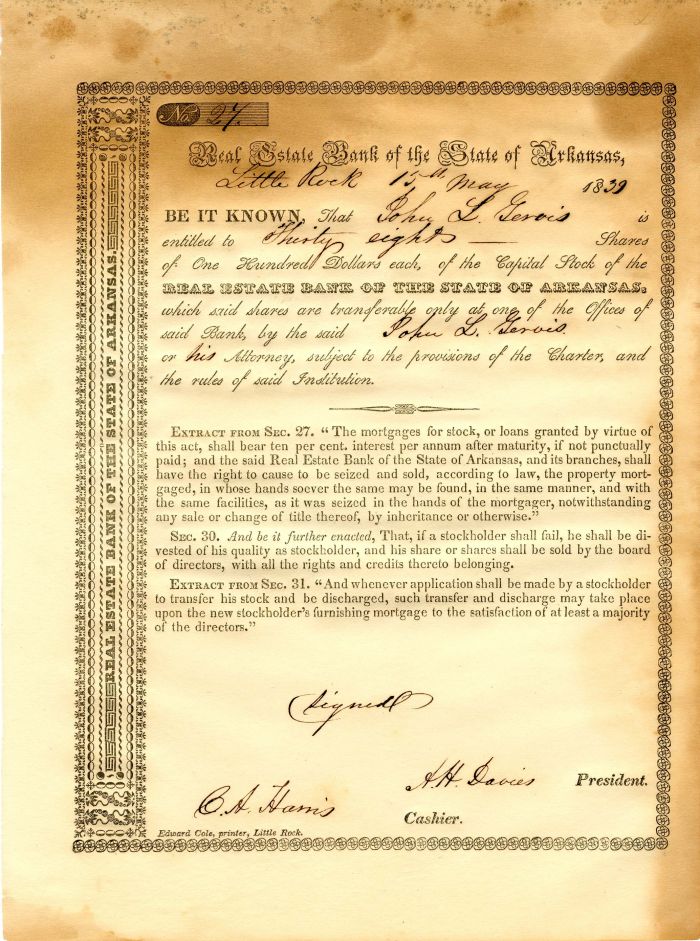Real Estate Bank of the State of Arkansas - 1830's Banking Stock Certificate
Inv# ES1015A Stock
Stock printed by Edward Cole-Little Rock. Historically Important! Rare! Early! Toned. The Real Estate Bank of Arkansas was a bank in Arkansas during the 1830s through 1850s. Formed in 1836, the bank had a troubled history with accusations of waste and favoritism, as well as violations of the bank's legal charter. The bank suspended specie payments in 1839 to allow it to lend out more money. Paper money issued by the bank lost value, and the bank entered trusteeship in 1842. An act of the Arkansas legislature approved of the transfer to the trustees in 1843, but the trustees did not forward information to the state and personally benefited from the arrangement. In 1853, the Arkansas legislature passed a bill to have the Arkansas Attorney General take the bank to chancery court, but the filing could not be made until 1854 because of lack of cooperation from the trustees. April 1855 saw the bank's assets transferred from the trustees to the state, and in 1856 the first full public accounting of the bank's finances was made. The bonds related to the bank were not fully extinguished until 1894, and a portion of them, known as the Holford Bonds, proved particularly problematic.
Support for a state bank in Arkansas began during the time of the Arkansas Territory. This was considered a priority due to a lack of banking west of the Mississippi River, a shortage of coins in the region, and few banks in the area being allowed to issue paper money. After Arkansas became a state, the 1836 establishment of the Real Estate Bank of Arkansas was the first piece of legislation passed by the new government. Politically, the bank was widely supported. Two Whigs, Anthony H. Davies and John Ringgold, produced the charter for the bank, and the legislature that approved its creation was controlled by the Democratic Party. The bank's officials were of a Democrat-to-Whig ratio that was similar to that of the state's population. The enabling legislation required the bank to issue $2,000,000 of bonded indebtedness at five percent, with a maturity in 25 years. The state government appointed a quarter of the bank's board of directors, but took no part in the active management of the organization. Another requirement of the bank was to send reports to the state legislature, and the bank could borrow on the state's credit. The bank was intended to promote the interest of planters, an intention that was stated in the enabling legislation. The banking committee in the state legislature was composed almost entirely of men representing planting areas along rivers, and the voting to establish the bank was only opposed by representatives from northern Arkansas. The interests in the northern portion of the state were somewhat appeased by the establishment of another state bank to have branches in Fayetteville and Batesville. Read more at https://en.wikipedia.org/wiki/Real_Estate_Bank_of_Arkansas
A stock certificate is issued by businesses, usually companies. A stock is part of the permanent finance of a business. Normally, they are never repaid, and the investor can recover his/her money only by selling to another investor. Most stocks, or also called shares, earn dividends, at the business's discretion, depending on how well it has traded. A stockholder or shareholder is a part-owner of the business that issued the stock certificates.









Ebay ID: labarre_galleries